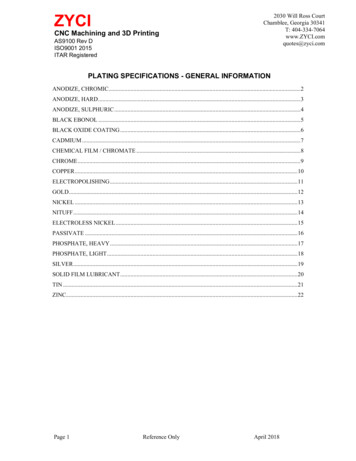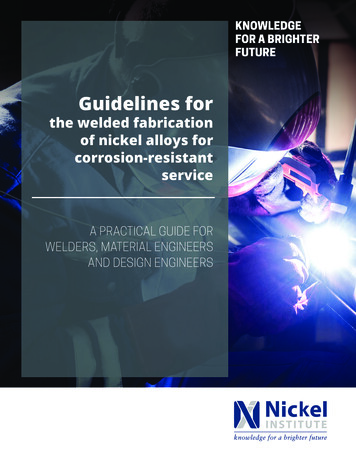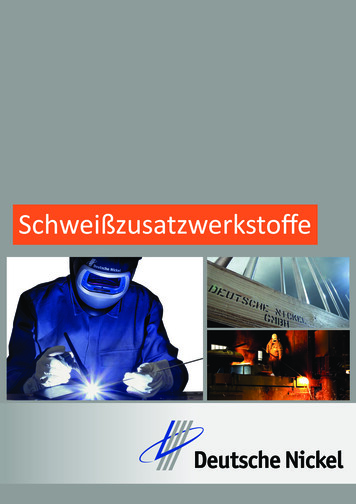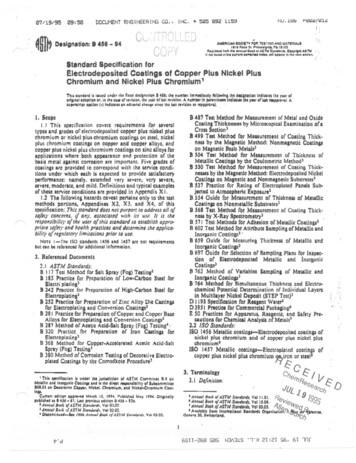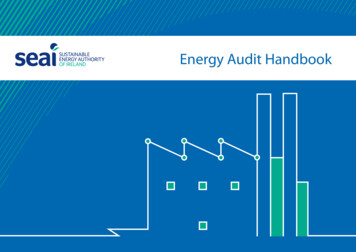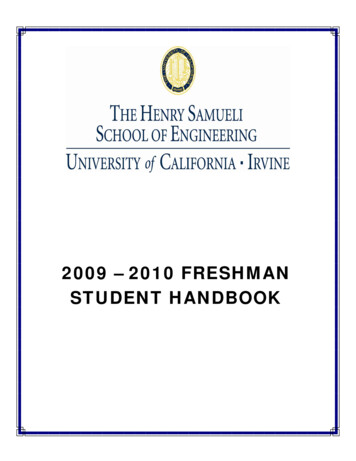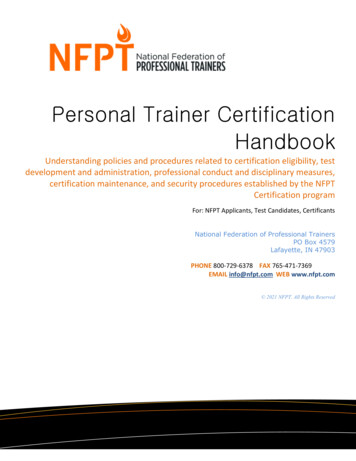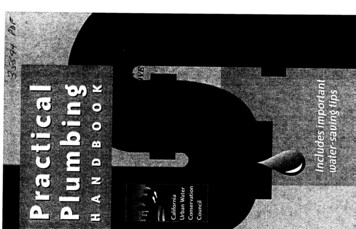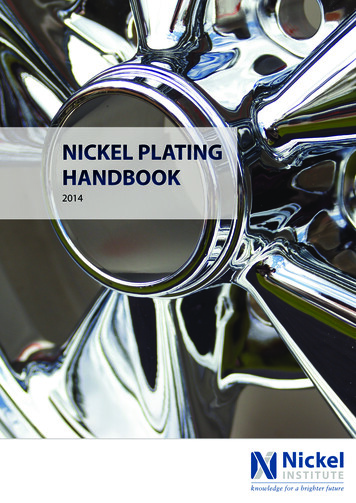
Transcription
NICKEL PLATINGHANDBOOK2014
ABOUT THE NICKEL INSTITUTENickel Institute (NI) is the global association of the world's primary nickelproducers who together account for approximately 85% of worldwide annualnickel production outside China. Our mission is to promote and support the useof nickel in appropriate applications. NI grows and supports markets for new andexisting nickel applications including stainless steel; and promotes science, riskmanagement and socio-economic benefit as the basis for public policy andregulation. Through our science division NiPERA (www.nipera.org), we alsoundertake leading edge scientific research relevant to human health and theenvironment. NI is the centre of excellence for information on nickel and nickelcontaining products and has offices in Asia, Europe and North America.TERMS IN THIS HANDBOOKTerms used in this publication relate to industry practice and are commonlyunderstood by plating professionals. The term decorative plating is used todescribe practices, processes and outcomes for a broad range of applications, butthe term decorative often masks the critical nature of the outcome required.Decorative plating processes often impart the technical and functional success ofthe products they are used on. Corrosion resistance, brightness and levelling,mechanical and physical properties are characteristics of these processes andcannot be discounted as cosmetic. 2013 Nickel Institute. All rights reserved. This Handbook may be reproduced, stored in a retrievalsystem or archive, or transmitted, in any manner or media now known or later devised, only withappropriate attribution to the Nickel Institute or the prior written consent of the Nickel Institute.DisclaimerThe material presented in the Handbook has been prepared for the general information of the reader,using the data available to us and the scientific and legal standards known to us at the time of itspublication. It should not be used or relied upon for any specific purpose or application withoutfirst securing competent professional advice. The Nickel Institute, its members, staff and consultantsmake no representation or warranty as to this Handbook's accuracy, completeness, or suitability forany general or specific use and assume no liability or responsibility of any kind in connection withthe information presented in it, including but not limited to any deviations, errors or omissions.Reference to this Handbook to any specific commercial product, process or service by trade name,trade mark, manufacturer, or otherwise does not necessarily constitute or imply its endorsement orrecommendation by the Nickel Institute.
CONTENTS1. Introduction.52. Understanding the Electroplating Process.6Basic Process of Electrodeposition.6Rate of Deposition.7Current Efficiency.8Average Coating Thickness.8Deposit Thickness Distribution. 10Current Distribution. 10Throwing Power. 11Internal Stress. 11Levelling and Microthrowing Power. 123. Chemistry of Nickel Electroplating Solutions. 13The Watts Nickel Plating Solution. 13Function of Ingredients. 13The Role of Addition Agents. 14Bright Nickel Plating. 14Auxiliary Brighteners. 15Anti-Pitting Agents. 15Semi-Bright Nickel Solutions. 15Sulphamate Nickel Electroplating Solutions. 15Other Nickel Electroplating Processes. 164. Anodes for Nickel Plating. 17Nickel Anode Requirements. 17Types of Nickel Anode Material. 18Titanium Anode Baskets. 19Power Consumption. 20Packing Density. 21Anode Fines. 21Anode Bags. 21Practical Tips for Maintenance of Nickel Anode Baskets. 22Anode Maintenance - Best Practice. 23Insoluble Anodes. 235. Decorative Nickel Plating. 25Bright Nickel Plating. 25Satin Nickel Plating. 25Nickel-Chromium Coatings for Exterior Service. 26Multi-Layer Nickel. 26Microdiscontinuous Chromium. 27Alternative Topcoats. 29Specifications for Decorative Nickel-Chromium Plating. 29Service Condition Number. 33Classification Number. 34Type of Copper Coating. 34Plating on Plastics Materials. 353
CONTENTS (continued)6. Engineering and Functional Nickel Coatings. 36Coating Requirements for Functional Applications. 36Types of Nickel Plating Solutions for Functional Applications. 36Electroforming. 39Mandrels. 40Electroforming Techniques. 407. Barrel Nickel Plating. 42Design of Plating Barrels. 42Type of Work Suitable for Barrel Plating. 43Barrel Loading. 43Barrel Nickel Plating Solutions. 43Voltage Requirements. 44Plating Rates and Metal Distribution. 448. Testing Procedures for Nickel Electrodeposits. 46Appearance and Surface Quality. 46Coating Thickness. 46Destructive Methods. 47Non-Destructive Methods. 47Adhesion. 49Ductility. 49Corrosion Resistance. 50Thermal Cycle Test. 51Accelerated Corrosion Testing of Plated Plastics Materials. 529. Controlling the Electroplating Process. 54Monitoring the Operating Conditions. 54Maintaining the Optimum Solution Composition. 56Control of Impurities. 60Purification Procedures. 6110. Trouble-Shooting. 64Common Types of Defects in Nickel Plating and Their Causes. 64Trouble-Shooting Techniques. 6611. Practical Tips. 68Effective Racking for Electroplating. 68Care and Maintenance of Plating Racks. 69Reducing Solution Losses. 70Avoiding Adhesion Problems Between the Semi-Bright andBright Nickel Coatings When Processing Dual-Layer Nickel. 70How To Avoid Chromium Problems in DecorativeNickel/Chromium Plating. 71Preventive Maintenance. 7212. Looking After the Environment. 73Waste Minimisation.
being plated therefore receives a coating of metal. The reverse effect occurs at the anode and, with a soluble anode, metal ions are formed through dissolution. For
